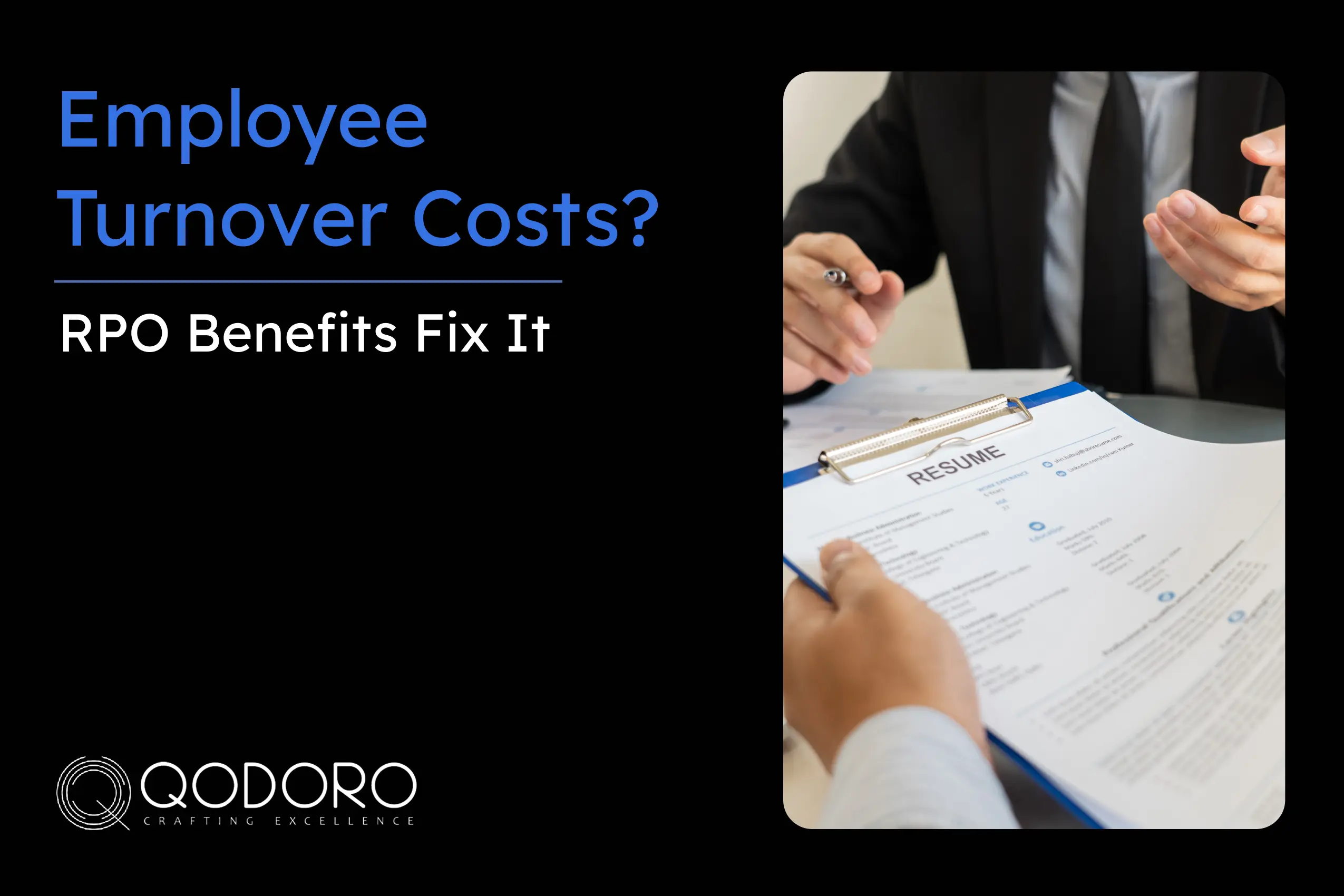
Published on: 10/10/2025

SHARE
Employee turnover isn’t just a number on an HR report, it quietly costs your business a lot. Most companies focus only on the obvious expenses, like job ads or recruitment agency fees. But the real impact goes much deeper. High turnover affects productivity, disrupts teams, and can hurt your company culture and long-term growth.
That’s where Recruitment Process Outsourcing (RPO) comes in. RPO helps reduce turnover costs and makes it easier to keep the right talent.
In this blog, we’ll look at the hidden costs of employee turnover and show how RPO benefits can help protect your workforce and get the most out of your recruitment efforts.
Many organizations underestimate the real cost when an employee leaves. The expenses go far beyond simply hiring a replacement. Understanding both the direct and indirect costs of turnover can help businesses see the bigger picture.
Direct costs are the most obvious. Recruitment expenses, such as posting job ads, using recruitment agencies, or attending career fairs, can quickly add up. In some industries, hiring a single employee can cost 50-60% of their annual salary. Onboarding and training are another major expense. New hires need time and guidance from HR and senior staff, as well as access to training materials and programs to get up to speed. Additionally, administrative costs like processing payroll, managing benefits, and handling legal documentation add to the financial burden.
But the hidden, indirect costs can be even more damaging. When a position is vacant, productivity suffers. Existing team members often have to take on extra work, which can lead to delays, mistakes, and even burnout. Even after a new hire joins, there’s a ramp-up period before they reach full productivity. High turnover also affects morale and engagement. Remaining employees may feel demotivated, trust within the team can weaken, and constant exits create uncertainty about job security. On top of that, departing employees take valuable knowledge and skills with them. Filling these gaps can slow down projects and impact client satisfaction.
In short, the cost of employee turnover goes far beyond just replacing a paycheck. It can ripple across the entire organization, affecting performance, company culture, and overall profitability.
High turnover disrupts workforce stability, which is critical for long-term organizational success. Workforce stability isn’t just about having employees in their roles; it’s about maintaining consistent team performance, preserving organizational knowledge, and fostering a positive workplace culture that supports engagement and growth.
Every time a key team member leaves, it affects relationships and workflows. Teams need to adjust, new members must integrate, and project timelines can shift. This constant change can reduce productivity, increase stress among remaining employees, and impact overall job satisfaction. When employees have to repeatedly pick up extra responsibilities, it can lead to frustration and burnout.
Frequent turnover also affects company culture and strategic focus. Organizations risk losing their core values, institutional knowledge, and the experience that drives effective decision-making. When teams are constantly handling vacancies or onboarding new hires, long-term initiatives often take a backseat to immediate operational demands. This cycle can reduce employee engagement, as staff feel they are stuck managing short-term crises instead of contributing to meaningful, long-term projects.
Maintaining workforce stability without a strategic approach to recruitment and retention is challenging. Traditional hiring methods may fill positions temporarily, but they don’t address the underlying issues causing turnover. Companies need proactive solutions that attract the right talent and keep them engaged, ensuring teams remain productive, cohesive, and aligned with organizational goals.
Related: RPO vs Traditional Hiring: Which One Works Better in 2025?
Recruitment Process Outsourcing (RPO) is more than just outsourcing hiring—it’s a strategic partnership that aligns recruitment with your long-term business goals. RPO providers manage all or part of your hiring process, helping reduce employee turnover costs while improving talent retention. By taking a proactive, strategic approach to recruitment, RPO ensures that businesses not only hire efficiently but also retain the right employees for the long term.
RPO providers use advanced recruitment strategies, tools, and data analytics to fill positions quickly and efficiently. By reducing vacancy periods, organizations can minimize lost productivity and keep projects on track. RPO also focuses on better candidate matching by evaluating skills, experience, and cultural fit. This approach increases the likelihood that new hires will stay longer and contribute effectively from day one. Overall, this streamlined process reduces disruptions caused by frequent hiring cycles and strengthens workforce stability.
One of the most significant advantages of RPO is its focus on long-term talent retention. RPO providers ensure cultural alignment by matching candidates with the organization’s values and work environment. They also prioritize skill fit, ensuring candidates have the expertise needed to contribute immediately. Additionally, RPO maintains a talent pipeline, keeping potential candidates ready for future roles. This proactive approach reduces the scramble for replacements when turnover occurs and helps minimize the indirect costs of employee exits, such as lost productivity and lowered morale.
Although investing in RPO may seem like an added expense at first, it delivers measurable ROI. Organizations save money through fewer recruitment agency fees, lower onboarding costs, and reduced turnover-related losses. RPO also improves the quality of hires, as better candidate-job alignment reduces early attrition and ensures employees are productive quickly. Faster hiring cycles and minimal downtime enhance overall business continuity. In essence, RPO transforms recruitment from a reactive function into a proactive strategy. The RPO benefits extend across cost efficiency, workforce stability, and long-term organizational growth.
To get the most out of Recruitment Process Outsourcing (RPO), organizations should follow a few key best practices.
First, it’s essential to choose the right RPO partner. Look for a provider that understands your industry, company culture, and specific talent needs. The best RPO partners act as an extension of your HR team, not just a hiring service, helping you build a strategic and consistent recruitment process.
Next, align recruitment strategies with your business goals. RPO works best when hiring efforts support long-term objectives, whether that’s scaling rapidly, improving employee retention, or diversifying skill sets. A recruitment strategy tied to organizational priorities ensures that every hire contributes to your company’s growth and stability.
Monitoring key metrics and continuously improving processes is also critical. Keep track of performance indicators such as time-to-fill, retention rates, cost-per-hire, and employee engagement. Regularly reviewing these metrics allows you to identify areas for improvement and ensures that RPO continues to deliver real value, including reduced turnover costs and stronger workforce stability.
Finally, foster internal collaboration. Integrate your RPO provider with internal HR teams, managers, and department heads. This collaboration ensures that hiring decisions are not only fast and efficient but also aligned with the company’s culture and strategic goals. By combining external expertise with internal insights, organizations can fully leverage RPO to attract and retain top talent.
High employee turnover can be expensive. The costs aren’t just obvious, like recruitment fees, they also include hidden impacts such as lost productivity, lower morale, and a less stable workforce. Companies that ignore these costs risk losing their competitive edge and valuable talent.
Recruitment Process Outsourcing (RPO) provides a strategic solution. By streamlining the hiring process, focusing on talent retention with RPO, and delivering measurable recruitment outsourcing ROI, businesses can reduce turnover costs, strengthen workforce stability, and support long-term growth.
Investing in RPO isn’t just about filling open positions. It’s about turning recruitment into a proactive, cost-effective strategy that keeps employees engaged and retained. Companies that leverage RPO benefits can lower the hidden costs of turnover, retain top talent, and ensure their workforce remains a strong driver of business success.
It’s the rate at which employees leave a company and need to be replaced.
It costs money and affects productivity, morale, team stability, and knowledge within the company.
By speeding up hiring, matching the right candidates, and focusing on keeping employees longer.
Yes, RPO helps keep teams stable with faster hiring, cultural alignment, and a ready talent pipeline.
It’s the value RPO delivers, like saving costs, hiring faster, retaining talent, and improving employee performance.

